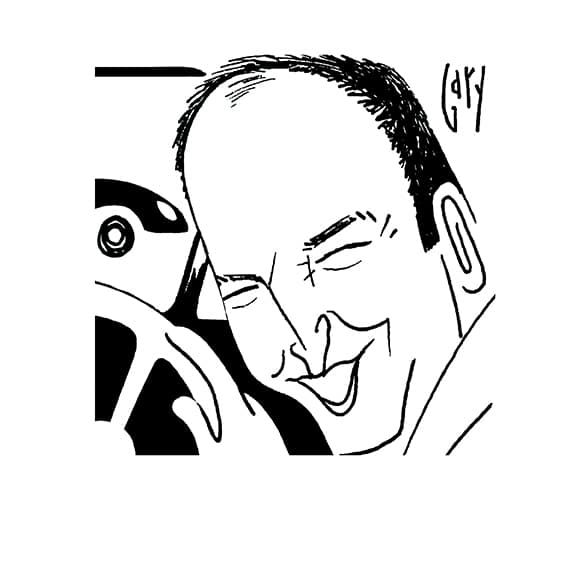Andrew Frankel: Beating the drum for disc brake pioneers Moss and Dewis
“Unlike many, Stirling Moss and Norman Dewis truly deserve to be called heroes”

And if I somehow managed to retain your interest to the end, you will have read of the film we made and my lament that for reasons unknown it never reached the light of day, signing off with: ‘How good it would be now to celebrate their extraordinary lives with its airing.’ I am ashamed to admit I may have had more than one motive for saying so.
For what I knew then was that the principal film-maker, Al Clark from Outrun Films, upon hearing of Stirling’s passing had taken it upon himself to delve back through the hours of footage and re-cut the film from scratch as The Racers That Stopped The World. And, apart from a few mercifully fleeting seconds where I prove that mine is indeed a fine face for radio, it is the most beautiful tribute to two men who unlike most who gain the title, really are worthy of being called heroes. And then there are fine contributions from Sir Jackie Stewart, Murray Walker, Martin Brundle and Derek Bell.
I don’t know anyone who knew Stirling and/or Norman who’s been able to get through it without welling up, and plenty who never met either but feel such a bond that they find themselves equally damp-eyed.
Anyway, I thought that publicising it in any way might microscopically increase the chance of it being noticed by a network and broadcast. I’m sure I had nothing to do with it, but all that really matters is Sky did indeed pick it up and it is on Sky Documentaries and Sky On Demand right now. If you see it, I hope you will agree that it’s a fine film and share my only sorrow, which is that neither of the boys lived to see it.
While I have been lucky enough to drive many hugely fast cars, I have spent very little time in hugely luxurious cars. I’ve not driven a Rolls-Royce in years and those Bentleys I’ve been in were either brief tests, or the more sporting models. I can’t imagine how sorry you must be feeling for me right now…
But recently I did a long drive around Europe in a Bentley Flying Spur, which is now its flagship model following the sad termination of the wonderful Mulsanne. And what I wanted to discover most was whether it really makes a difference. Do you really arrive after a dozen hours at the wheel-less tired than in, say, a large 2-litre diesel Audi saloon?
And there are downsides, like the purchase and running costs, and even the fact you always have to know where you’re going to park five and a bit metres of Bentley safely. You can’t just leave it at the side of the road – or at least I couldn’t with someone else’s car – and you take on multi-storey car parks at your considerable peril.
But such considerations are massively outweighed by the positives a car like the Spur can bring to such a journey. The seats, for instance, are unimprovable, and after 800 miles, that really counts. The ride quality has the same eerily well-controlled smoothness whether you’re four- up with a full boot or alone. It is a genuine pleasure to drive. There is a feeling of well- being that comes from being aboard something of immense intrinsic quality. Of course you sense it every time you step aboard, but never more than when you have many hundreds of miles ahead. It’s just a better place to be, and when you’re there for hour after hour, that’s actually what matters most.
There really isn’t anyone like Gordon Murray left in this industry because cars just aren’t designed by individuals any more, if they ever were. And Gordon would be first to point out that his McLaren F1-replacing GMA (Gordon Murray Automotive) T50 is the work of many people. But, like the F1, the T50 is his vision and his alone. He has talented staff and world- class suppliers like Cosworth for its 652bhp 3.9-litre V12 and Xtrac for its six-speed manual gearbox, but all are working to Murray’s brief.
“Like the F1, the T50 is Gordon Murray’s vision, and his alone”
When I saw the car, I wondered why more aren’t made this way, for the clarity, focus, innovation and determination not to compromise that are the hallmarks of all his designs for road or track shines through.
It reminded me of one of my favourite cars from another era, another superlight design intended for use on both road and track. Ferdinand ‘Butzi’ Porsche III earned his place in history as the designer of the car that would become the Porsche 911, but his favourite was actually the 904 road racer. And why? Because after Porsche’s largely unsuccessful foray into Formula 1, it was decided a proper sports racing car was needed quickly. So Butzi just sat down and did it. There simply wasn’t time for Porsche’s usual collegiate approach to such matters. The result was a two-seat Porsche coupé of astonishing beauty that sired the successive generations of prototypes that led directly to the 917. The 904 won its class in every round of the 1964 World Sports Car Championship it contested and the Targa Florio outright. Whether the T50 will race remains to be seen. It has not been designed as a racing car, but Gordon didn’t design the F1 to race, and that didn’t stop it taking four of the first five places at Le Mans at the first time of asking – including the win. We will see.

